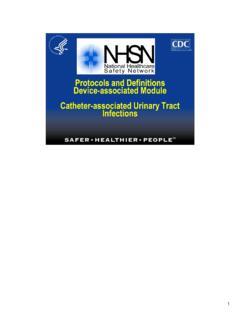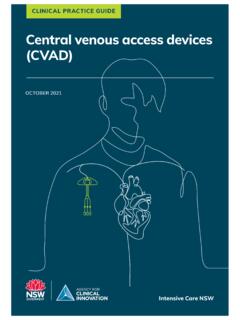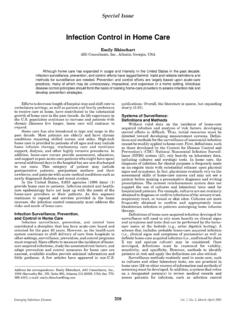Transcription of 2022 NHSN Patient Safety Component Manual
1 January 2018 National Healthcare Safety Network (NHSN) Patient Safety Component Manual Table of Contents Chapter 1: National Healthcare Safety Network (NHSN) Overview Chapter 2: Identifying Healthcare- associated infections (HAI) for NHSN Surveillance Chapter 3: Patient Safety Monthly Reporting Plan and Annual Surveys Chapter 4: bloodstream Infection Event (Central Line- associated bloodstream Infection and non-central line- associated bloodstream Infection) Chapter 5: Central Line Insertion Practices (CLIP) Adherence Monitoring Chapter 6: Pneumonia (Ventilator- associated [VAP] and non-ventilator- associated Pneumonia [PNEU]) Event Chapter 7: Urinary Tract Infection (Catheter- associated Urinary Tract Infection [CAUTI] and non-catheter- associated Urinary Tract Infection [UTI]) and Other Urinary System Infection (USI) Events Chapter 9: Surgical Site Infection (SSI) Event Chapter 10: Ventilator- associated Event (VAE) Chapter 12: Multidrug-Resistant Organism & Clostridium difficile Infection (MDRO/CDI) ModuleChapter 15: CDC Locations and Descriptions and Instructions for Mapping Patient Care Locations Chapter 16: General Key terms Chapter 17: CDC/NHSN Surveillance Definitions for Specific Types of infections Please Note: The NHSN Patient Safety Component Manual is updated annually based on subject matter expert review and user feedback.
2 Over time, certain chapters have been retired or moved to other components. To avoid confusion, the chapters in the PSC Manual do not shift to account for these changes; therefore, chapters 8, 11, 13, and 14 are not listed in the Table of Contents or included in this document. January 2018 1-1 NHSN Overview National Healthcare Safety Network (NHSN) Overview The NHSN is a secure, Internet-based surveillance system that expands and integrates Patient and healthcare personnel Safety surveillance systems managed by the Division of Healthcare Quality Promotion (DHQP) at the Centers for Disease Control and Prevention. In addition, facilities that participate in certain reporting programs operated by the Centers for Medicare and Medicaid Services (CMS) can do so through use of NHSN. Furthermore, some states use NHSN as a means for healthcare facilities to submit data on healthcare- associated infections (HAIs) and transfusion-related adverse events mandated through their specific state legislation.
3 NHSN enables healthcare facilities to collect and use data about HAIs, adherence to clinical practices known to prevent HAIs, the incidence or prevalence of multidrug-resistant organisms within their organizations, trends and coverage of healthcare personnel Safety and vaccination, and adverse events related to the transfusion of blood and blood products. The NHSN includes five components: Patient Safety , Healthcare Personnel Safety , Biovigilance, Dialysis, and Long-term Care Facility (Figure 1). Figure 1: NHSN Components NHSN ComponentsPatient SafetyLong-term Care Facility Outpatient DialysisHealthcare Personnel Safety BiovigilanceJanuary 2018 1-2 NHSN Overview The Patient Safety Component includes four modules that focus on events associated with medical devices, surgical procedures, antimicrobial agents used during healthcare, and multidrug resistant organisms.
4 Device- associated Module:oBloodstream Infection (CLABSI Central line- associated bloodstream infection)oCentral line insertion practices (CLIP) adherenceoUrinary Tract Infection (CAUTI Catheter- associated urinary tract infection)oVentilator- associated events (VAE) (adult locations only)oPneumonia (VAP Ventilator- associated pneumonia) - in pediatric locations (in-plan* oroff-plan*), or NICU and adult locations (off-plan* only) Procedure- associated Module:oSurgical site infection (SSI) Antimicrobial Use and Resistance Module (AUR) Multidrug-Resistant Organism and Clostridium difficile Infection (MDRO/CDI) Module*Note: In-plan surveillance means that the facility has committed to following the NHSN surveillance protocol, in its entirety, for that particular event, as shown in the facility s NHSN monthly reporting plan.
5 Off-plan surveillance is surveillance that is done because a facility has decided to track a particular event for internal use. Data that are entered into NHSN off-plan are not included in NSHN annual reports or other NHSN publications. A facility makes no commitment to follow the NHSN protocol for off-plan events. Further, off-plan data cannot be uploaded into NHSN via Clinical Document Architecture (CDA) and must be manually entered. Instructions and standardized surveillance methods and definitions for each module of the Patient Safety Component are provided in this Manual and on the NHSN website ( ). Modules may be used singly or NHSN Long-term Care Facility Component provides long-term care facilities (LTCFs) with standardized surveillance methods and definitions for three modules: (1) Multidrug resistant organism (MDRO) and Clostridium difficile Infection (CDI) laboratory-identified (LabID) Events; (2) Urinary Tract infections (UTI); and (3) Prevention Process Measures.
6 The Component is ideal for use by nursing homes, skilled nursing facilities, chronic care facilities, and assisted living and residential care facilities. LTCF surveillance protocols, training materials, data collection forms, instructions, and other supporting materials are provided on the Long-term Care Facility Component website: Outpatient hemodialysis centers have several surveillance options tailored to their patients and setting in the Dialysis Component . The Component consists of 3 modules: 1) Dialysis Event; (2) Prevention Process Measures; and (3) Dialysis Patient Influenza Vaccination. Facilities that treat hemodialysis outpatients should refer to the Dialysis Component instructions and standardized surveillance methods and definitions at There are two modules in the Healthcare Personnel Safety (HPS) Component of NHSN: the Healthcare Personnel Exposure Module and the Healthcare Personnel Vaccination Module.
7 These modules may be used separately or simultaneously. Instructions and standardized surveillance methods and definitions for each module are provided in the NHSN Manual : HPS Component Protocol January 2018 1-3 NHSN Overview The NHSN Biovigilance Component , Hemovigilance Module facilitates national surveillance of transfusion-related recipient adverse events. The Hemovigilance Module is designed for transfusion service staff to collect data on annual facility and transfusion service characteristics, individual reports on adverse transfusion reactions, errors or accidents associated with adverse reactions, and monthly counts of transfused or discarded components. The Hemovigilance Module surveillance protocol, training materials, data collection forms, instructions, and other supporting materials are provided on the Hemovigilance Module website: Surveillance Techniques Some of the options in the following modules require active, Patient -based, prospective surveillance of events and their corresponding denominator data by a trained Infection Preventionist (IP).
8 This means that the IP shall seek out infections during a Patient s stay by screening a variety of data sources, such as laboratory, pharmacy, admission/discharge/transfer, radiology/imaging, and pathology databases, as well as Patient charts, including history and physical exam notes, nurses /physicians notes, temperature charts, etc. Others may be trained to screen data sources for these infections , but the IP must make the final determination. Laboratory-based surveillance should not be used alone, unless all possible criteria for identifying an infection are solely determined by laboratory evidence (for example, LabID event detection in the MDRO/CDI Module). Retrospective chart reviews should be used only when patients are discharged before all information can be gathered. NHSN forms should be used to collect all required data, using the NHSN definitions of each data field.
9 To minimize the IP s data collection burden, others may be trained to collect the denominator data and process of care data (for example, central line insertion practices). Procedure- associated Module Surgical site infection (SSI) monitoring is offered through this module. SSI surveillance requires active, Patient -based, prospective surveillance techniques (see Surveillance Techniques above). To minimize IPs workload of collecting denominator data, operating room data may be downloaded (see file specifications at: ) Both pre-discharge and post-discharge surveillance methods should be used to detect SSIs. Surveillance may include both inpatient and outpatient operative procedures. These methods include 1) direct examination of patients wounds during hospitalization, or follow-up visits to either surgery clinics or physicians offices, 2) review of medical records or surgery clinic Patient records, 3) surgeon surveys by mail or telephone, and 4) Patient surveys by mail or telephone (though patients may have a difficult time assessing their infections ).
10 Any combination of these methods is acceptable for use; however, CDC criteria for SSI must be applied. Device- associated Module Medical instrumentation increases the risk of development of an HAI and most patients admitted for health care are exposed to some kind of medical device in the course of their treatment. Such devices include, but are not limited to, vascular and urinary catheters, and ventilators. NHSN enables facilities to monitor infectious complications associated with the use of these devices and also to monitor January 2018 1-4 NHSN Overview processes related to their use which might increase infection risk. Specifically, surveillance of central line- associated bloodstream infection (CLABSI), catheter- associated urinary tract infection (CAUTI), ventilator- associated events (VAE), and/or ventilator- associated pneumonia (VAP) is possible using the NHSN.













